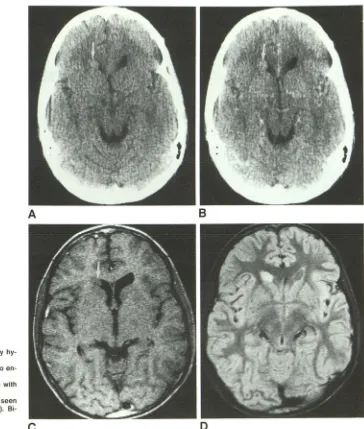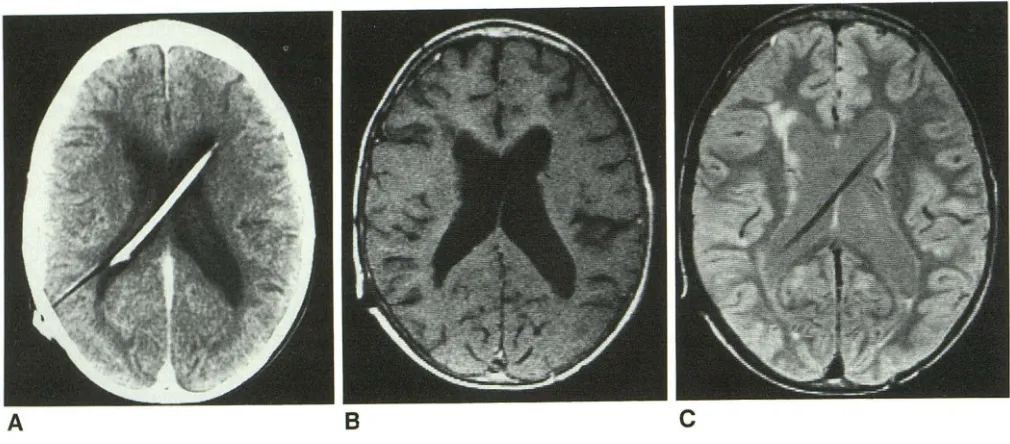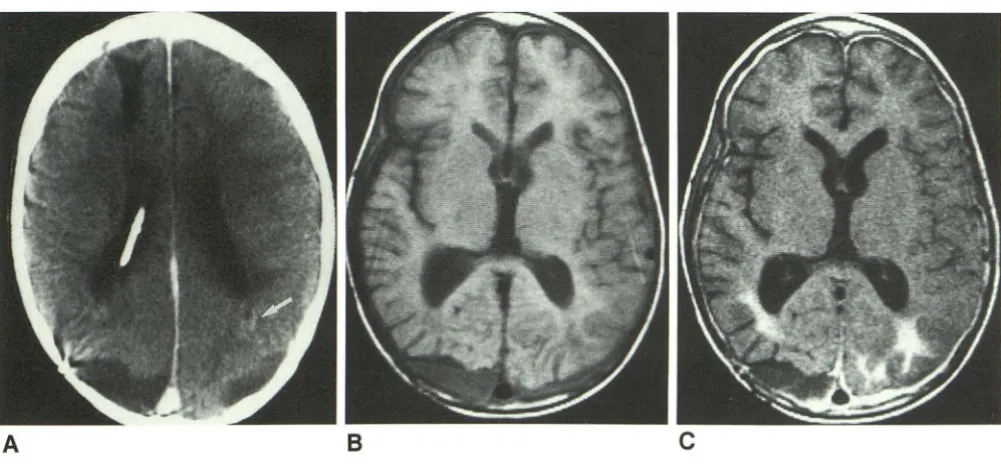N. Rollins1 D. Mendelsohn2
A.
Mulne3 R. Barton1·4 J. Diehl1
N. Reyes3 F. Sklar-5
Received August 18, 1989; revision requested October 11, 1989; revision received November 1,
1989; accepted November 9, 1989.
'Department of Radiology, Children's Medical Center, 1935 Motor St., Dallas, TX 75235. Address reprint requests to N. Rollins.
2 NMR Imaging Center, University of Texas Southwestern Medical Center, Dallas, TX 75215.
3 Department of Pediatrics, University of Texas
Southwestern Medical Center, Dallas, TX 75215. 'Present address: Department of Radiology, University of Alabama, Birmingham, AL 35233.
5 Neurosurgeons for Children, Dallas, TX 75225. 0195-6108/90/1103-0583
© American Society of Neuroradiology
Recurrent Medulloblastoma:
Frequency of Tumor Enhancement on
Gd-DTPA MR Imaging
583
Thirty-two children with medulloblastoma were evaluated postoperatively with con-ventional and gadolinium-enhanced MR imaging. Eleven patients had abnormal cranial MR studies; nine of these had recurrent tumor. In six patients recurrent tumor enhanced with Gd, while in the other three patients recurrent tumor did not enhance. The remaining two patients had areas of abnormal Gd enhancement that were caused by radiation
-induced breakdown of the blood-brain barrier rather than by recurrent tumor.
This study shows that not all recurrent medulloblastoma enhances and that the absence of Gd enhancement does not necessarily indicate the absence of recurrent tumor.
AJNR 11:583-587, May I June 1990; AJR 155: July 1990
Initial reports describing the use of MR imaging in children with brain tumors
have suggested that the use of gadolinium (Gd) improved the accuracy of MR in the diagnosis of recurrent or residual tumor [1, 2]. We undertook a study with Gd-enhanced MR imaging in children with recurrent medulloblastoma to examine the enhancement pattern of this tumor and to determine if the use of Gd would have a significant effect on MR results in this clinical setting.
Materials and Methods
Between July 1988 and June 1989 we examined 32 children, 18 months to 16 years old, who had been treated for medulloblastoma. All tumors were initially located in the fourth ventricle. All patients had undergone previous surgical resection followed by radiotherapy andjor chemotherapy; 28 patients were undergoing routine follow-up examinations and four
patients had progressive neurologic complaints that suggested tumor recurrence.
MR was performed on a 0.35-T superconducting magnet (Diasonics MTfS, Milpitas, CA).
Precontrast studies included T1-weighted spin-echo images, 500/30/2 (TR/TEjexcitations),
in the sagittal and axial planes and T2-weighted images (2500/40,80/2) in the axial andjor coronal planes with a pixel size of 0.95 mm and an image matrix of 256 x 256. Informed consent for the use of Gd was obtained under the guidelines of the Institutional Review Board of the University of Texas Southwestern Medical Center. Following slow IV administration of
Gd-DTPA (Berlex Laboratories, Cedar Knolls, NJ) in a dose of 0.1 mmjkg body weight, T1
-weighted sagittal, axial, andjor coronal images were acquired.
Twenty-seven patients also had head CT scans within 72 hr of MR imaging. The usual CT examination consisted of 1 0-mm nonenhanced axial images. After bolus administration of iodinated contrast material in a dose of 2 mljkg body weight, 5-mm contiguous axial sections
were taken.
Results
Eleven of the 32 patients evaluated had abnormal cranial MR studies (Table 1 ).
584
ROLLINS ET AL. AJNR:11, May{June 1990TABLE 1: Recurrent Medulloblastoma: Patterns of Enhancement
Case Enhancement on Enhancement
Site of Recurrence Gd-Enhanced Comment
No. MR Imaging on CT
4th ventricle No No Routine follow-up; on chemotherapy;
biopsy proved
2 Right frontal lobe No No Routine follow-up; off chemotherapy;
biopsy proved
3 4th and lateral ventricles No No Routine follow-up; on chemotherapy
4 4th, 3rd, and lateral Moderate enhancement in No Routine follow-up; on chemotherapy
ventricles 4th ventricle,
nonen-hancing tumor in lateral and 3rd ventricles
5 4th ventricle and lepta- Yes N/A Symptomatic recurrence; off
chemo-meninges therapy
6 4th ventricle and lepta- Yes Yes Tumor progression; on chemotherapy;
meninges positive CSF cytology
7 4th ventricle and lepta- Yes Yes Tumor progression; on chemotherapy;
meninges positive myelogram
8 Suprasellar cistern Yes No Routine follow-up; chemotherapy;
posi-tive myelogram
9 Right frontal horn Yes No Biopsy proved
10 Abnormal enhancement in Yes N/A Resolved 3 months later without therapy
occipital white matter
11 Abnormal enhancement in Yes Minimal Radiation necrosis
occipital white matter
Note.-NfA = not available.
A
B
c
Fig. 1. -Case 1.
A, Spin-density MR image (2500/40) shows nodule projecting into fourth ventricle, which had shown no change over 2. years. Biopsy-proved recurrence. 8 and C, The nodule (arrow) failed to enhance with either Gd-enhanced MR (8) or CT (C).
enhanced and three showed no enhancement with Gd. Two
patients had areas of abnormal Gd enhancement that
sub-sequently resolved and were attributed to radiation-induced
breakdown of the blood-brain barrier. There were no cases in
which tumor enhanced by CT and not with Gd-enhanced
imaging. Five of the six patients with enhancing tumors were receiving chemotherapy at the time of the examination. Two of the three patients with nonenhancing recurrent
medulla-blastoma on Gd-enhanced MR imaging were on chemother-apy. No patients were receiving exogenous steroids.
In case 1 , recurrent tumor in the posterior fossa had been present unchanged for the preceding two years. No enhance-ment occurred with Gd-enhanced MR imaging or CT. The
T2-weighted images were most suggestive of recurrent
[image:2.615.57.548.93.335.2] [image:2.615.55.558.370.589.2]AJNR:11, May/June 1990 MR OF RECURRENT MEDULLOBLASTOMA 585
interval, failed to enhance with either CT or MR imaging, and
was best demonstrated with T2-weighted images (Fig. 2).
In case 3 (Fig:. 3) there was subtle irregularity of the epen-dymal surface of the lateral ventricles, which could be
appre-ciated both with CT and Gd-enhanced MR imaging. The tumor
nodules failed to enhance with either technique and the diagnosis of tumor recurrence was best made with the T2-weighted images. Within a given patient, some tumor nodules enhanced and others did not, as illustrated in case 4 (Fig. 4).
Case 6 (Fig. 5A) demonstrates typical beam-hardening and
metallic artifact in the posterior fossa on CT, exacerbated by the radioactive seeds that had been surgically implanted as treatment for recurrent fourth ventricular medulloblastoma. The lack of beam-hardening and metallic artifact with MR and the intense Gd enhancement demonstrated by this recurrent tumor made Gd-enhanced MR imaging more sensitive than CT (Fig. 58). In addition, the sagittal images allowed graphic depiction of tumor within the suprasellar cistern and along the
Fig. 2.-Case 2.
A, Nonenhanced CT scan shows slightly hy-perdense nodule (arrow).
B, Contrast-enhanced CT scan shows no
en-hancement.
C, The nodule (arrow) did not enhance with
Gd-enhanced MR.
D, Discrete hyperintense nodule was seen best on spin-density MR image (2500/40). Bi-opsy proved recurrence.
A
c
leptomeninges of the anterior interhemispheric region (Fig.
5C).
Two patients (cases 10 and 11) had abnormal enhancement
in the occipital white matter that was presumed to represent radiation-induced disruption of the blood-brain barrier. Radia
-tion-induced necrosis demonstrated more enhancement with
Gd than it did with contrast-enhanced CT (Fig. 6).
Discussion
There are no large series describing the enhancement
pattern or clinical utility of Gd-enhanced MR imaging in c hil-dren with recurrent medulloblastoma. Powers et al. (2] de-scribed two cases of medulloblastoma, both of which showed
intense Gd enhancement, but commented that although the
use of Gd allowed identification of additional lesions, lesions could apparently be identified in the nonenhanced studies. Bird et al. (1] described two patients with medulloblastoma
8
[image:3.613.194.558.301.730.2]586
ROLLINS ET AL. AJNR:11, May/June 1990Fig. 3.-Case 3.
A, Contrast-enhanced CT scan shows subtle irregularity of lateral ventricles with no abnormal enhancement.
B, Small ependymal nodules failed to enhance with Gd-enhanced MR. C, Metastases are shown well on spin-density image (2500/40).
Fig. 4.-Case 4. Gd-enhanced MR image shows mod-erate enhancement of recurrent tumor in fourth ventricle,
while metastases in
the region of third ventricle fail to en-hance.
who had abnormal nonenhanced MR studies. The first case
showed local Gd enhancement that was presumed to
repre-sent tumor recurrence although biopsy was not performed
and no follow-up was provided. The second case showed no
abnormal enhancement. The authors suggested incorrectly that the absence of enhancement indicated the absence of
tumor.
Our material shows that not all recurrent tumor enhances
and that the absence of Gd enhancement does not
necessar-ily exclude residual or recurrent tumor. For these reasons, T2-weighted MR images should be obtained in all patients.
Conversely, the presence of Gd enhancement does not
nec-essarily indicate the presence of tumor, since abnormal Gd
enhancement may be due to disruption of the blood-brain barrier induced by radiotherapy.
By CT, the typical medulloblastoma is a well-defined slightly hyperdense, relatively homogeneous mass filling the fourth
ventricle [3]. Although most medulloblastomas demonstrate moderately intense enhancement with iodinated contrast ma-terial, up to 7% of primary tumors do not enhance [4]. The primary tumors in all our patients did enhance by CT at presentation and the reason for the failure of some of the recurrent tumors to enhance with Gd is unclear; no patients were receiving exogenous steroids that might have altered the blood-brain barrier or tumor vascularity. It is not clear why fourth ventricular recurrence enhanced in one patient while other recurrent intracranial disease elsewhere in the same patient demonstrated no appreciable enhancement.
Two of the patients with nonenhancing medulloblastoma recurrence underwent diagnostic craniotomies. Histologic re-view of the tumors showed them to be well differentiated with numerous Homer-Wright rosettes, low mitotic rates, and no large areas of necrosis. Histologic review of the recurrent tumors that displayed intense Gd enhancement showed them to have large pleomorphic cells with a high mitotic rate and large areas of necrosis. Although our series is too small to draw any conclusions, it appears that the enhancement
pat-tern may parallel the histologic pattern and may have some prognostic significance. The four patients who had nonen-hancing recurrent tumor had a fairly prolonged clinical course
and slow growth of tumor on subsequent scans, while the patients who showed intense Gd enhancement of recurrent
tumor tended to have a more rapid demise, generally after a
few months.
Although the intent of this study was not to compare the
sensitivity of MR with that of CT, it appears that the addition
of Gd did render MR a more sensitive imaging method than nonenhanced MR or enhanced CT. However, as some
recur-rent tumors do not enhance, Gd-enhanced images should not
replace T2-weighted images; rather, they should be used as
[image:4.615.55.560.79.301.2] [image:4.615.58.297.350.522.2]AJNR:11, May/June 1990 MR OF RECURRENT MEDULLOBLASTOMA 587
A
8
c
Fig. 5.-Case 6.
A, Beam-hardening and metallic artifact mask tumor on CT scan.
B, Intense enhancement in residual tumor is unobscured with Gd-enhanced MR image. C, Leptomeningeal spread of tumor is best seen on enhanced sagittal MR images.
A
8
c
Fig. 6.-Case 9.
A, CT scan shows minimal enhancement of occipital white matter (arrow), presumed to represent radiation necrosis. No regions of abnormal enhancement were present on any other images.
B, No hyperintense areas are seen on nonenhanced T1-weighted MR image.
C, Marked enhancement is seen in occipital white matter bilaterally on Gd-enhanced MR image.
REFERENCES
1. Bird CR, Drayer BP, Medina M, et al. Gd-DTPA-enhanced MR imaging
in pediatric patients after brain tumor resection. Radiology 1988; 169:
123-126
2. Powers TA, Partain CL, Kessler AM, et al. Central nervous system lesions
in pediatric patients: Gd-DTPA-enhanced MR imaging. Radiology 1988;
169:723-726
3. Sandhu A, Kendall B. Computed tomography in management of
medullo-blastomas. Neuroradiology 1987; 29:444-452
[image:5.615.54.560.78.289.2] [image:5.615.55.556.341.574.2]


